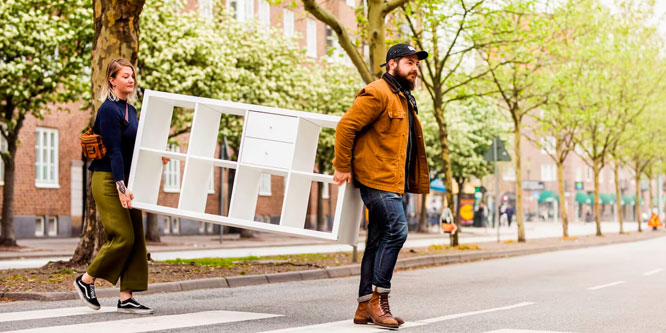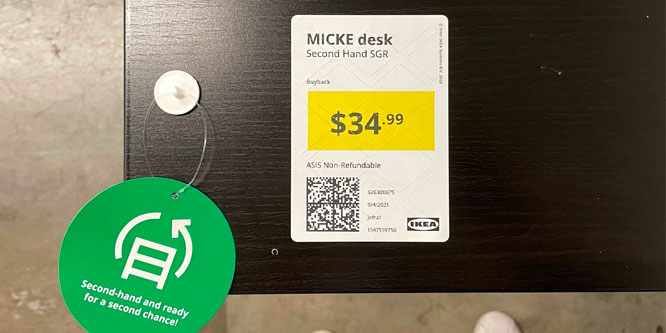
Photo: IKEA
Is IKEA’s furniture buy-back initiative sustainable?
IKEA is making its Buy Back & Resell program permanent across its 37 U.S. stores following a pilot last summer.
The service applies only to used IKEA furniture that is fully assembled and functional. Acceptable products include office drawer cabinets, bookcases, small tables, dining tables, desks and chairs and stools without upholstery. IKEA will not take back beds, sofas, mattresses, home furnishing accessories, leather products or lighting fixtures.
The retailer will sell the items in its As Is in-store sections that also stock discontinued items and ex-showroom displays.
Used furniture sellers earn an IKEA store credit. In the U.K. and Ireland where the program has been rolled out, sellers receive between 30 to 50 percent of the original price.
“Do you have IKEA furniture that’s an oldie, but it’s still a goodie, and looking to retire it?” IKEA states on its website. “By finding your furniture a new home, we are making the things we love last longer.”

The program aligns with IKEA’s goal to become climate positive by 2030.
In the soft goods space, Levi’s, Patagonia, The North Face, Madewell, Allbirds, Fabletics and Eileen Fisher are among those recently launching initiatives that let customers return items for store credit. The programs come as Gen-Z’s passion for sustainability is supporting strong growth across a wide range of apparel resale platforms, including ThredUp, The RealReal, Poshmark and Depop.
Furniture re-commerce faces challenges, however, such as the shipping of bulky items, but it’s starting to be touted as the next growth opportunity.
Last week, Kaiyo, an online marketplace for furniture resale, raised $36 million in a funding round. The New York-based startup said it experienced more than 100 percent growth year-over-year due to growing interest in the circular economy and pandemic-induced supply chain issues.
”Furniture is one of the largest investments consumers make, yet historically, re-selling has posed a significant challenge, making it a major contributor to landfill waste,” Alpay Koralturk, founder and CEO, said in a statement.
Other places selling used furniture include Kaiyo competitors, AptDeco and Chairish, as well as Craigslist and Facebook Marketplace.
- Buy Back & Resell – IKEA
- Shop your store’s As-Is products – IKEA
- Earth Month 2022: Small actions make a world of difference – IKEA
- Online Furniture Marketplace Kaiyo Raises $36 Million In Series B To Accelerate Expansion, Led by Edison Partners – Kaiyo/PRNewswire
- Gen Z’s Passion for Sustainability Boosts Resale Market, First Insight’s New Report Finds – First Insight/Business Wire
- Kaiyo gets $36M Series B for its secondhand furniture marketplace – TechCrunch
- Used furniture is about to become a $16.6 billion business. Even Ikea is getting in on it – Fast Company
- The Biggest Trends In Furniture Resale – Forbes
Discussion Questions
DISCUSSION QUESTIONS: Do you see more benefits than potential drawbacks to IKEA’s expanding Buy Back & Resell program? What do you think of the overall growth potential of furniture re-commerce?


IKEA has often been at the cutting edge of sustainability for such a large organization. This solves multiple consumer needs, including making furniture more affordable for both the buyer and seller and helping individuals meet their own sustainability goals.
While the shipping aspect adds complexity, there are many companies out there trying to fix that element as well. IKEA’s investment in this program will only help.
I suppose the pilot has proven the business merits for IKEA, but I am not convinced this program has many environmental benefits. If a piece is still good enough to resell at IKEA, it’s unlikely to be headed for a landfill. It’s much more likely to be sold hyper-locally on NextDoor or at a local consignment shop. Or donated locally.
I like the idea of retailers owning their resale markets more. From a customer-relationship perspective, it keeps shoppers in the brand’s ecosystem post-purchase, which can be especially hard to accomplish in a category such as furniture. If IKEA could own the logistical piece of retrieving the item back, this would be even better. Either way though, this is additional customer data the retailer gets to own.
The resale market for furniture has grown rapidly over the past couple of years. Some of this is because of product shortages in new stock, some is down to a more frugal mindset, and some is because of people opting to be more sustainable. Many of these drivers are still in play and, as such, the market is still growing. Although resale will remain a small part of IKEA’s overall business, it is sensible for them to play in this arena.
IKEA is better positioned than most to make a furniture resale program successful for the long term because of their network of physical stores. Shoppers are far more likely to purchase a used item when they have the ability to see the level of wear in person, and the ability to avoid high shipping charges by picking up in-store. IKEA is doing a great job of moving their sustainability goals forward in meaningful ways to the shopper. Now I have a way to trade in my old Billy bookcases!
This concept has a high degree of volume uncertainty associated with it. Initially it will be hard to predict how much volume the model will attract and, consequently, how and where to process and store such buybacks. Maybe over time the volume will become more stable and predictable — and maybe it never will.
This is a good thing for IKEA to do. I doubt that it will have either a negative or positive impact on their financials – but that’s not the reason to do it. In truth, I’m more interested in how it creates a secondary market which will help people with less means than I am the green part of the initiative. But it’s a good idea.
Reselling and reusing furniture makes sense. At the moment my perception is that market activity is mostly small scale, thrift stores and person-to-person sales. I question how big this will be for IKEA however. I love IKEA but let’s be honest, I wouldn’t consider their furniture to be especially durable. I don’t think anyone expects to pass along their IKEA bookshelf and table to the next generation. If this initiative can keep some of those items out of the landfill, that’s a good thing. I don’t think, however, that it will have much impact on IKEA’s bottom line or the secondary market.
From a carbon footprint standpoint, great to see. IKEA buyers are generally mid to lower income households based on the price point and product feature/functionality. How well their product “holds up” to use that it could be attractive for resell, that is the question. The intent is more significant than what the result will be.
I feel that re-commerce is on the cusp of being huge for many categories of merchandise, not just apparel. Thanks IKEA, for backing that notion up. I have three “older” children and they haven’t bought anything new in years. Gens A, Z, and Y; they all really get re-commerce for its many benefits. Now if we can get Boomers on board, the mission will be complete.
It is just the message, “By finding your furniture a new home, we are making the things we love last longer.” that IKEA wants to get out there. It is a meaningful message. Though, I doubt anyone would want my wife’s used IKEA desk. Including her. But my niece, with her first apartment, would be a buyer.
I agree with several of my colleagues. This may be more successful for the local reseller than IKEA.
As an avid thrift store shopper, I love the idea of brands being able to maintain more ownership of their re-commerce. IKEA has some classically popular pieces that have a lot of life left in them. I think we’ll continue to see that “one man’s trade will be another man’s treasure” across a variety of expensive items like furniture, outdoor gear, luxury clothing, etc.
Disposing of used or unwanted furniture is perhaps the top decorating pain point for most people. Having the ability to dispose/recycle furniture through a retailer is a great service and a differentiator for the brand. Obviously, there are a lot of logistical challenges associated with this type of program. I would however approach this as a customer benefit and not just a sustainability initiative. Home pickup would be something customers would appreciate and perhaps could be aligned with an online purchase. I would also assume that margin management will become an issue as will brick-and-mortar space to accommodate a resell section. Knowing that IKEA conducted a test and is now rolling it out would mean that they can scale this successfully, so I am excited to keep watching.
The logistics of this are interesting. Presumably used furniture is sold fully assembled, as in the picture that accompanies this piece, but will customers disassemble it to have it fit in a car? Love the idea, but I’m not sure about the execution.
I have high hopes for sustainability and the circular economy, but for IKEA’s Buy-Back & Resell concept to make a big impact, two things need to be true:
(1) IKEA products need to be made durably well enough to survive their use in the home and the rigors of transport back to the retailer fully assembled.
(2) The IKEA solution has to be equally or more attractive compared with direct local selling on Facebook marketplace, Craigslist or similar.
The composite materials (MDF) and fasteners used in much IKEA furniture are quite strong and its designs are well engineered, so I’d expect the company has good confidence about point #1.
But the ad hoc resale market for home furniture is already established. In many instances, it is up to the buyer to come pick up the item — a big convenience for sellers. So I think the jury is out on point #2.
I do like that IKEA offers the advantage of a trusted platform. Not every seller wants a face-to-face interaction with a buyer. Giving good usable furniture a second life instead of an early grave in the landfill is commendable, however it happens.
An oldie, but it’s still a goodie:suffice it to say that’s not a phrase one particularly associates with IKEA — and there’s the additional problem that they haven’t had to make room for built-out items, so will have to increase their storage space — but we’ll just have to see how it goes. There are a number of reasons companies don’t like to sell used items — quality control, no depth of stock, and — of course! — it discourages buying new, so whether this is a paradigm shift or just a fad, only time will tell.
I feel that IKEA’s resell strategy has both benefits and drawbacks. Recycling and repurposing old furniture is a great way to appeal to Gen Z customers, who are always on the lookout for brands that cling to sustainable values. Moreover, IKEA, this way can also offer a unique product assortment to give customers more styles to choose from and give an edge to decor experiences.
However, getting the furniture to IKEA stores could be a significant challenge. IKEA would have to ensure that furniture is handled with care while also adjusting logistics expenses. Secondly, not all furniture would be suitable for re-commerce. Foam or leather couches, for example, cannot be resold if they are damaged or ripped.